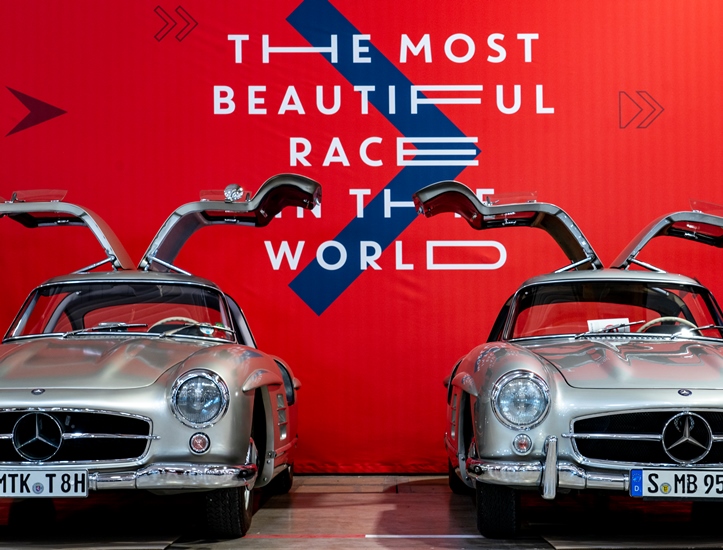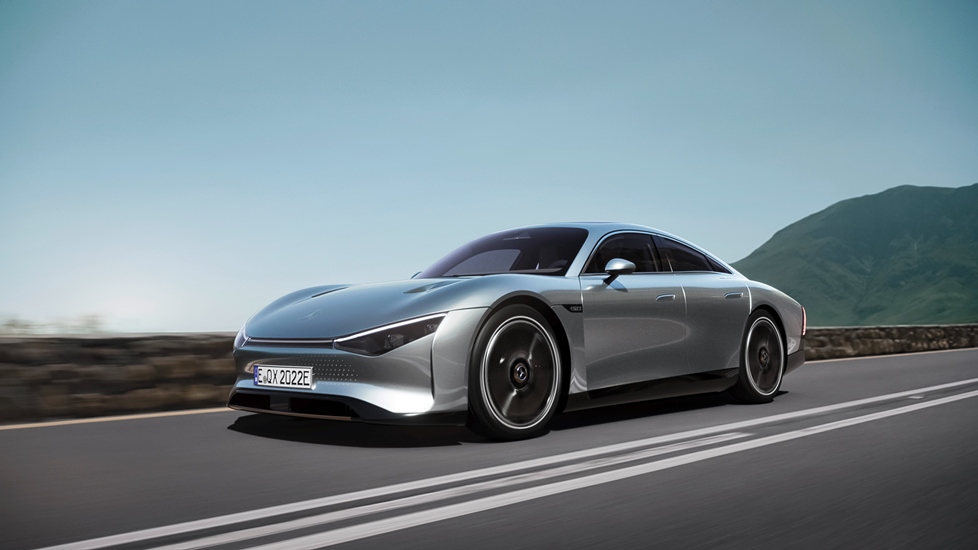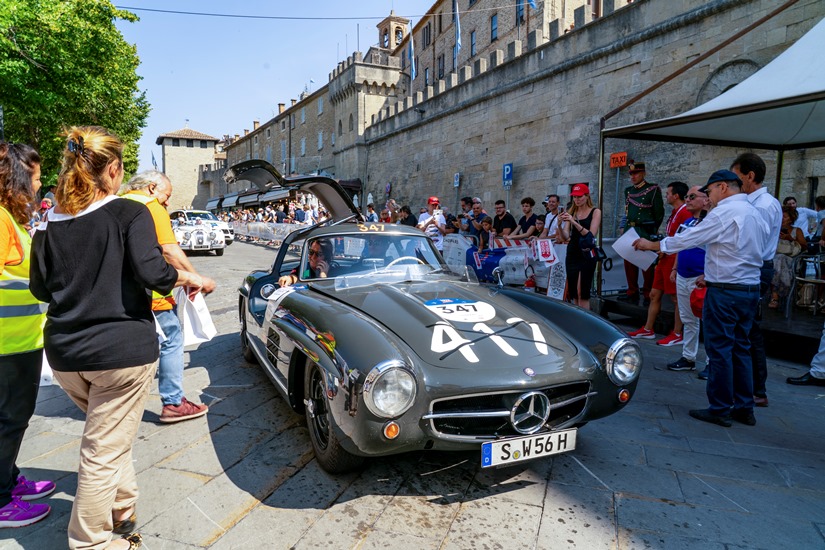
At this year’s 1000 Miglia, icons of the past will meet icons of the future: Mercedes-Benz Classic is taking part in the world-famous regularity race on the trail of the road race with two 300 SL (W 198) models and a Mercedes-Benz SS (“Super Sport”).
Mercedes-Benz will also be bringing the VISION EQXX technology platform to the 1000 Miglia Green, the regularity race for vehicles with alternative drive systems. This year, the event will take place from 13 to 17 June 2023.
“Pioneering spirit and innovation are in the DNA of Mercedes-Benz. For the first time, Mercedes-Benz is not only participating in this year’s 1000 Miglia with classic vehicles: We are also taking part in the accompanying 1000 Miglia Green with the VISION EQXX along with EQS and EQE SUV. With this, automotive icons of the past meet the electric icons of the future. And we are once again underlining our clear commitment to sustainability and electrification.” – Ola Källenius, Chairman of the Board of Management of Mercedes-Benz Group AG
The 300 SL “Gullwing” stands for the brand with the star like no other vehicle: the innovative super sports car, introduced in 1954, won its class in the 1955 Mille Miglia with an outstanding triple victory. Other automobiles from the brand’s history and current portfolio are part of the field of what is probably the best-known and most attractive event for classic vehicles in the world.
“Outstanding innovativeness and pioneering spirit have always been strengths of Mercedes-Benz. Our vehicles at this year’s 1000 Miglia exemplify this: be it the supercharged sports car from 1930, the 300 SL Gullwing from the 1950s or the VISION EQXX of today, all are innovators of their time. Since the invention of the automobile, our brand has repeatedly paved the way for mobility with breakthrough innovations. In the long-distance classic and the future format 1000 Miglia Green, these cars will show from Brescia to Rome and back how the unique heritage of the world’s oldest luxury car manufacturer is also shaping its future.” – Marcus Breitschwerdt, Head of Mercedes-Benz Heritage
Historical fascination and modern sustainability
Around 400 vehicles embark on the 1000-mile journey through some of Italy’s most beautiful landscapes, with stops in Brescia, Cervia-Milano Marittima, Rome, Parma and Milan. Hundreds of thousands of spectators await the field along the route and celebrate the drivers and their automobiles: that’s how it was back then, when the Mille Miglia was held as a pure road race between 1927 and 1957.
And so it is to this day. Because in 1977, the 1000 Miglia was reborn as an outstanding regularity race for classic cars. With numerous special stages, it demands full concentration from the teams. And on many sections of the route, some classics reach their performance limits.
Since 2020, the 1000 Miglia Green has complemented the classic event. The focus here is on electric mobility. In 2023, a small starting field of all-electric vehicles will drive the 1000-mile route. One of the most modern representatives in the field of participants is the technology platform Mercedes-Benz VISION EQXX.

With a range of more than 1,202 kilometres (746 miles) on a single battery charge and energy consumption of less than 10 kWh/100 km, the VISION EQXX is a blueprint for the future of efficiency. In addition to the state-of-the-art electric drivetrain, the world-leading drag coefficient of Cd = 0.17 and lightweight construction based on the concept of bionics, the VISION EQXX pioneers a radical new software-driven UI/UX approach.
Mercedes-Benz is bringing not only the unique VISION EQXX to the 1000 Miglia Green, but also an EQE SUV and an EQS.
At Mercedes-Benz, however, sustainability does not just begin on the road, but in the early stages of product development. CO₂ emissions and resource consumption are both considered in a holistic approach.
During the development of the vehicles, the composition of all materials to be used is already reviewed and possibilities for more sustainable alternatives are examined. The vehicles are designed to be as resource-efficient as possible throughout their entire life cycle. Mercedes-Benz calls this process “Design for Environment”.
Super sports car and innovation platform of the 1950s: The 300 SL
First Mercedes-Benz passenger car with direct petrol injection, consistent lightweight construction, breathtaking performance for its time and the victorious racing sports car of the same name from 1952 as its technical basis: the Mercedes-Benz 300 SL production sports car (W 198) had its world premiere in 1954 at the International Motor Sports Show in New York.
It caused a sensation among experts and the public alike and set standards as a super sports car of its era. Several 300 SL Coupé models from Mercedes-Benz Classic built in 1955 and 1956 will compete in the 1000 Miglia.
The SL legend was born through the successes of the 300 SL racing sports car (W 194). It made its debut in 1952 at the Mille Miglia. With a weight of only 1,310 kilograms and an output of 158 kW (215 hp), the 1954 production sports car derived from the racing car was also predestined for victories in motorsport.
It proved this most impressively with the class victory in the 1955 Mille Miglia. The coupé with the characteristic gull-wing doors became a brand icon and one of the most sought-after classics of all. Also planned for the 1000 Miglia is the use of a 1930 Mercedes-Benz SS supercharged sports car of the W 06 model series. In total, only 111 of these vehicles were built. Like the K and S models before it, the SS used another innovation of automotive engineering: a compressor for mechanical charge air compression.
However, the displacement was increased from 6.8 litres in the Type S to 7.1 litres in the Type SS. With the on-demand compressor, this produced more than 200 hp. This model was later developed into the SSK and SSKL and was thus the forerunner of the winning car of the Mille Miglia 1931.
Renowned drivers and unique history
In addition to the Head of Mercedes-Benz Heritage, Marcus Breitschwerdt, the drivers of the valuable classics include two brand ambassadors of the brand with the star: five-time DTM champion Bernd Schneider is one of the world’s fastest and most successful touring car and GT drivers.
Karl Wendlinger, former Mercedes Junior, won several rounds of the World Sports Car Championship with the Sauber Mercedes Team in 1990 and 1991. He started in 41 Formula One races until 1995. In addition, Ellen Lohr, former works driver for Mercedes-Benz in the DTM, will be piloting one of the vehicles in the brand’s EQ fleet; she is also a regular participant in the tour of Italy.
On the evening before the official race, all teams starting with a Mercedes-Benz vehicle will meet for an exclusive brand evening. The almost two dozen privately used cars of the brand include the 300 SL (W 198), 190 SL (W 121) and 220 (W 180) models. Only classic cars whose models were part of the starting field in the years of the first Mille Miglia era from 1927 to 1957 are permitted to take part in the 1000 Miglia.
The history of this thousand-mile race is closely linked to Mercedes-Benz. The victory achieved by Rudolf Caracciola and Wilhelm Sebastian is legendary. They became the first non-Italian team to win Mille Miglia in 1931 – with the Mercedes-Benz SSKL (W 06 RS). In 1955, Stirling Moss and Denis Jenkinson took overall victory in a Mercedes-Benz 300 SLR (W 196 S).
Their performance still inspires many motorsport fans today: The British duo covered the distance in ten hours and seven minutes with an average speed of just under 160 km/h on a road course over numerous mountain passes, among other things.
This record was never broken. Given that the last race was in 1957, the record will stand for eternity. In the 1955 race, the Mercedes-Benz 300 SL production sports cars also won in the Gran Turismo class with over 1.3 litres of displacement, and the 180 D (W 120) won the diesel passenger car classification.
































